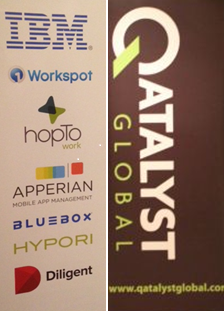Enterprise Mobility & the Connected Worker Blog
Recap: Qatalyst Global’s Managing BYOX & End User Mobility conference
Managing BYOX Event Recap
At Qatalyst Global’s Managing BYOX & End User Mobility conference, organizations such as PG&E, Fairfield University, and Aetna shared their experiences integrating mobile initiatives, while vendors including Apperian, Bluebox Security, Dilligent, IBM, and WorkSpot, explained how their mobile services could increase company productivity and efficiency. We had the opportunity to speak with several of the end users in attendance about their BYOx approaches — not surprisingly, most were still challenged by the complexities of implementing BYOx policies and proving the ROI of these initiatives. The Fairfield University’s CIO, Paige Francis gave a great presentation that illustrated how heavily mobile technology was relied on by her student body and how important it will be going forward to understand the expectations of future generations of workers and customers. Francis spoke at length about the difficulties of meeting student and employee technology needs in a campus environment and how Service Oriented Architecture concepts now applied to mobility (she described this as “Mobile Oriented Architecture”). We agree, as mobile devices and services will need to seamlessly interact with one another independently.

End Users Know They Need to Deliver a Positive User Experience
Companies at the conference were at all different stages of their mobile journey exemplifying the differing pace of adoption. Some companies stood out, PG&E for example has developed and deployed a number of mobile applications to enhance field service operations as well as meet customer needs. Interestingly, the utilities industry, which had remained fairly stagnant in regards to technology over the past few years now stands positioned to develop rapidly as mobile and IoT technologies are incorporated to enhance business processes. Other industries such as health care have been keen to embrace mobile technologies, but issues surrounding contractual and regulatory obligations complicate initiatives. However, a major take away from the conference has to be that keeping it simple in both development and deployment is essential. Focusing on the end user — how the end user will use and experience the technology — can guide the process fairly completely, while financial constraints remain important considerations. As Steve Damadeo — the IT Ops Manager for Festo — explained, BYOD and mobile applications provide ample cost-saving opportunities as well as productivity gains if implemented with a focus on cost containment and user experience.
Privacy Considerations Important Going Forward
Providing a unique and outside perspective on the legal obstacles facing multinational corporations’ mobile plans was VDC Research’s own Eric Klein. His presentation touched on one of the many impediments to crafting an effective technology policy that incorporates mobile; from security and privacy concerns to regulatory and user experience issues. Achieving compliance with laws and regulations that are often archaic in relation to modern technology can be cumbersome. Case law as explained by my colleague Eric Klein has failed to keep up with technological development – particularly with regards to mobile technology. Baker & McKenzie’s data privacy and security expert Harry Valetk was in agreement, and spoke at length about this topic and echoed many of these sentiments. While it will take time, the case law will catch up, Valetk predicted that “regulators and courts will apply the laws as they are today regardless of if they more accurately regulate the technology of 20 years ago”.
Note: This was a recap of the first day (7/15) of the 2-day event.
View the 2017 Enterprise Mobility & Connected Devices Research Outline to learn more.